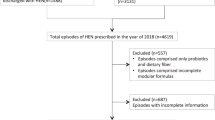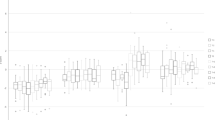Abstract
Objective:
The wide spread use of long-term enteral nutrition and the substantive costs dictate a need to study outcome, clinical and epidemiological characteristics of these patients. The aim of our study was to analyze incidence and characteristics of a cohort of patients on HEN during 6 years, after our previous pilot study of 3 years.
Design:
Prospective observational study.
Setting:
Tertiary care.
Subjects:
Between January 1999 and December 2004, all adult patients living in Valladolid West area who were discharged from the hospital on HEN were prospectively studied and followed up.
Interventions:
Information for each patient was prospectively recorded by the dietitian of the team, and include age, sex, body mass index, tricipital skinfold, midarm circumference, underlying disease, exitus, dates of initiation and discontinuation of HEN, nutrient formula, mode of administration and complications of HEN. During HEN, physicians supervised the home patients and the patients themselves or their close relative, were asked to contact our nutrition team if any problem occurred. Finally the yearly incidence of HEN was calculated each year on the basis of the estimated population in our area of recruitment, assuming almost all HEN patients were reported.
Results:
In our previous study, incidence of HEN in 1999 was patients 15 per 100 000 inhabitants, 21.3 in 2000 and decreased to 9.52 in 2001. In the new 3 years, the incidence remained in the mean levels of 1999 and 2000, the data were 17.1 per 100 000 inhabitants 26.5 in 2003 and 25.6 in 2004. The mean age of all patients was 56.4±17 years. The distribution of patients by diseases was; (43.8%) had a head and neck cancer, (26.8%) had human immunodeficiency virus infection, (9.6%) had a neurological disorders affecting swallowing (cerebrovacular accident and/or dementia), (4.7%) had diseases in digestive tract (fistulae, pancreatic disease, inflammatory bowel disease), (2.5%) had tumors in different locations with anorexia, (5%) had head trauma, and (7.6%) had one of several miscellaneous diseases inducing dysphagia or anorexia. HEN was administered via oral in 258 patients (70.6%) (group I), via a NGT in 95 patients (26.1%), a PEG in 9 patients (2.5%), and a jejunostomy in 3 patients (0.8%) (group II=107 patients). During the course of HEN, 12 patients had diarrhea (3.3%) and 8 (2.2%) constipation, and 4 vomiting (1.1%) that did not require cessation of HEN. No lung aspiration was detected. Hypernatremia (sodium >145 meq/l) appeared only in six cases (1.64%) and 12 cases of hyperglycaemia (3.28%). Ten patients (2.8%) reported a least one problem with the tube. The mean duration of HEN was 148.2±104 days. After the follow-up, 19 of the 365 patients (5.2%) had died, 346 (94.8%) were alive. In multivariant analysis, an independent factor associated with death was age (hazard ratio: 1.22; 95% CI: 1.06–1.39), adjusted by sex, route and diagnosis.
Conclusions:
HEN has a high incidence in our area and it is a valid and safe technique for nutrition support.
This is a preview of subscription content, access via your institution
Access options
Subscribe to this journal
Receive 12 print issues and online access
$259.00 per year
only $21.58 per issue
Buy this article
- Purchase on Springer Link
- Instant access to full article PDF
Prices may be subject to local taxes which are calculated during checkout
Similar content being viewed by others
References
Bordel-Marchasson I, Dumas F, Pinganaud G (1997). Audit of percutaneous endoscopic gastrostomy in the long-term enteral feeding in a nursing home. Int j Qual Health Care 4, 297–302.
Castano Escudero A, Perez Garbada ME (2004). Home enteral nutrition in Madrid. Nutr Hosp 19, 68–72.
Castillo Rabaneda RM, Gomez Candela C, de Cos Blnco AI (1998). Evaluation of the cost of home enteral nutrition in relation to different access routes. Nutr Hosp 13, 320–324.
De Luis DA, Aller R, de Luis J, Izaola O, Romero E, Terroba MC et al. (2003). Clinical and biochemical characteristics of patients with home enteral nutrition in an area of Spain. Eur j Clin Nutr 57, 612–615.
Elia M (1995). An international perspective on artificial nutritional support in the community. Lancet 345, 1345–1349.
Gomez Candela C, de Cos AL, Iglesias C, Carbonell MD (1999). Artificial nutrition in the home. Annual information 1996. Roup NADYA-SENPE. Nutrition Hosp 14, 145–152.
Greif J, Golden BA (1995). Home administration of nutritional & medical therapies for persons with AIDS. Caring 14, 34–36.
Hebuterne X, Bozzeti F, Moreno Villarés J (1999). Home enteral nutrition in adults: A multicentre study in Europe. Clin Nutr 18 (suppl 1), 21.
Howard L, Ament M, Fleming C (1995). Current use and clinical outcome of home parenteral and enteral nutrition therapies in the United States. Gastroenterology 109, 355–365.
Hull MA, Rawlings J, Murray FE (1993). Udit of long-term enteral nutrition by percutaneous endoscopic gastrostom. Lancet 341, 869–872.
Lilley AJ, Manthorpe J (2003). The impact of HEN in every day: a qualitative study. Health Soc Care Community 11, 122–127.
Midorikawa Y, Suzuki K, Motohashi G, Shimazagi J (2003). Review of our HPN and HEN. Gang go Kagaku Ryoho 30, 137–153.
Nehra V, Swails W, Duerksen D, Babineau T, Bistrian BR (1999). Indications for total parenteral nutrition in the hospitalized patient: a prospective review of evolving practice. J Nutr Biochem. 10, 2–7.
Planas MN, Castella M, Garcia Luna PP, Pares RM, Chamarro J, Camarero E et al. (2004). Home enteral nutrition: National resgister 2001. Nutr Hospita 19, 145–149.
Roberge C, Tran M, Massoud C (2000). Quality of life and home tube feeding: a French prospective study in patients with head and neck or oesophageal cancer. Br J Cancer 82, 263–269.
Schneider SM, Raina C, Pugliese P, Pouget I, Rampal P, Hebuterne X (2001). Outcome of patients treted with home enteral nutrition. JPEN 25, 203–209.
Silver HJ, Wellman NS, Arnold DJ, Livinsgtone AS, Byers PM (2004). Older adults receiving HEN: enteral regime, provides involvement and heath out comes. A J P and En Nu 28, 92–98.
Wicks C, Gimsn A, Vlavianos P (1992). Assessment of the percutaneous endoscopic gastrostomy feeding tube as part of an integrated approach to enteral feeding. Gut 33, 613–616.
Author information
Authors and Affiliations
Corresponding author
Rights and permissions
About this article
Cite this article
de Luis, D., Aller, R., Izaola, O. et al. Experience of 6 years with home enteral nutrition in an area of Spain. Eur J Clin Nutr 60, 553–557 (2006). https://doi.org/10.1038/sj.ejcn.1602354
Received:
Revised:
Accepted:
Published:
Issue Date:
DOI: https://doi.org/10.1038/sj.ejcn.1602354
Keywords
This article is cited by
-
A retrospective analysis on epidemiological characteristics of home enteral nutrition: results from a Chinese tertiary hospital in 2018
European Journal of Clinical Nutrition (2021)



